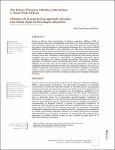| dc.contributor.author | Assaf Silva, Nayiv Amin Jesus | |
| dc.date.accessioned | 2021-01-22T18:06:00Z | |
| dc.date.available | 2021-01-22T18:06:00Z | |
| dc.date.issued | 2020-09-30 | |
| dc.identifier.doi | http://dx.doi.org/10.32870/Ap.v12n2.1910 | |
| dc.identifier.uri | https://hdl.handle.net/11285/637055 | |
| dc.description.abstract | Based on Moore's three interactions of distance education, Hillman, Willis & Gunawardena, proposed a technological interaction in the instructional domain, the learner-interface interaction. Twenty-six years after their proposal, considering the high degree of technologization of educational technology due to its link to artificial intelligence, this interaction is more valid than ever. This article develops the past, present and future of this fourth interaction. The three most important technological areas related to education are presented, for the future development of the learner interface interaction: Evaluation of technological interactions in the learning domain (Usability and user experience), Capabilities of intelligent educational agents (Artificial intelligence and natural language processing) and Scope of predictive algorithms in education (Deep learning and big data), as fundamental elements, although not the only ones, for the design of the next generation of 2D and 3D intelligent multimedia interactive interfaces for educational purposes. The need for a unified interactional model, based on the Anderson-Moore triangular interactional model, is raised, and the Anderson equivalence theorem is taken to hypothesize a possible future scenario in the short, medium and long term for highly technological education. | es_MX |
| dc.format.medium | Texto | es_MX |
| dc.language.iso | eng | es_MX |
| dc.publisher | Universidad de Guadalajara | es_MX |
| dc.relation.isFormatOf | versión publicada | es_MX |
| dc.relation.url | http://www.udgvirtual.udg.mx/apertura/index.php/apertura/article/download/1910/1234 | es_MX |
| dc.rights | openAccess | es_MX |
| dc.rights.uri | http://creativecommons.org/licenses/by-nc/4.0 | es_MX |
| dc.subject | HUMANIDADES Y CIENCIAS DE LA CONDUCTA::PEDAGOGÍA::TEORÍA Y MÉTODOS EDUCATIVOS | es_MX |
| dc.subject.lcsh | Education | es_MX |
| dc.title | The future of learner-interface interaction. A vision from EdTech | es_MX |
| dc.type | Artículo/Article | es_MX |
| dc.identifier.eissn | 2007–1094 | |
| dc.identifier.journal | Apertura | es_MX |
| dc.identifier.orcid | https://orcid.org/0000-0002-8370-7233 | es_MX |
| dc.subject.keyword | Human-computer interaction | es_MX |
| dc.subject.keyword | learner-interface interaction | es_MX |
| dc.subject.keyword | AI | es_MX |
| dc.subject.keyword | EdTech | es_MX |
| dc.subject.keyword | intelligent agents | es_MX |
| dc.subject.keyword | tech design | es_MX |
| dc.subject.keyword | covid-19 | es_MX |
| dc.subject.keyword | Instructionality | es_MX |
| dc.identifier.volume | 12 | es_MX |
| dc.identifier.issue | 2 | es_MX |
| dc.identifier.startpage | 1 | es_MX |
| dc.identifier.endpage | 25 | es_MX |
| dc.contributor.affiliation | Instituto Tecnológico y de Estudios Superiores de Monterrey | es_MX |
| dc.subject.country | México / Mexico | es_MX |
| dc.identificator | 4||58||5801 | es_MX |

